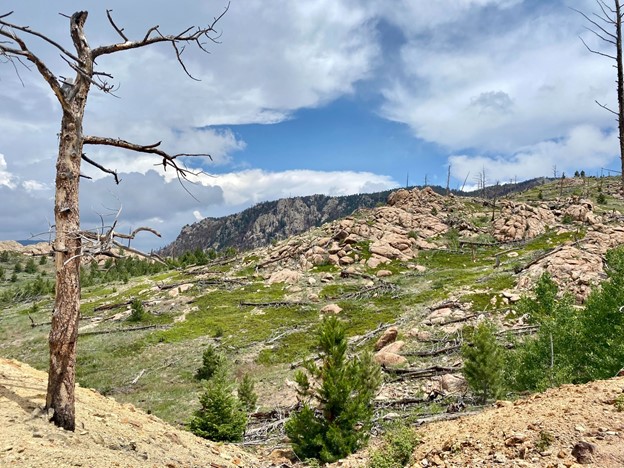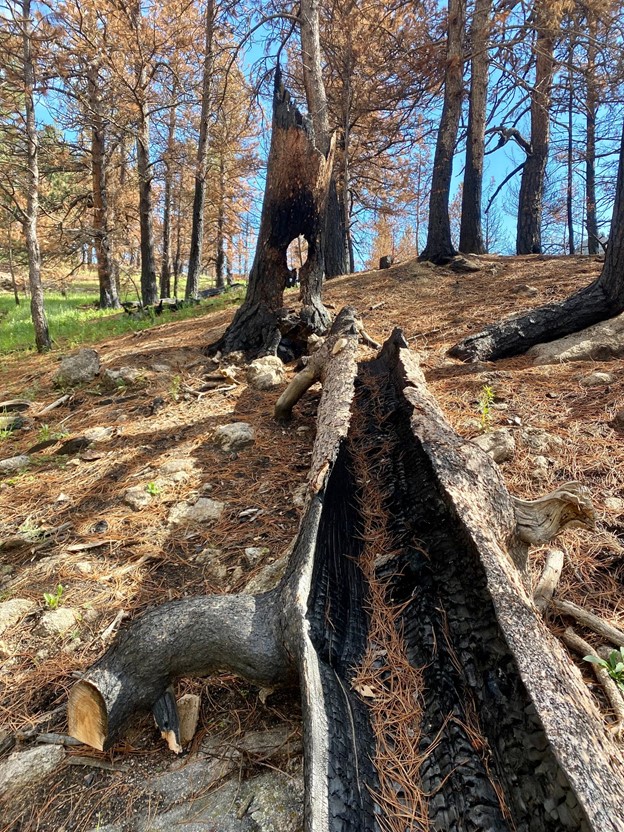Colorado: Flowers and Fires
July 6, 2021
By Isaac K.
 On Thursday we hiked up Fairview Peak, which stands at an elevation of 8,500 feet. Going uphill, we passed through a “ghost forest” – a swathe of trees killed by a recent fire. Some of the trees had fire-resistant bark, which meant their exoskeletons survived but the fire hollowed them out on the inside, leaving a husk. Forest fires are the type of ecological disturbance that doesn’t eliminate all life and nutrients from the environment, and the process of regrowth is called secondary succession. The ghost forest was in its sixth stage of secondary succession, the area repopulated by bushes and small trees. From a distance, the forest looked like a blight on the mountainside, but up close it was vibrant. You got the sense that it was in the process of becoming something new, like a butterfly in a cocoon.
On Thursday we hiked up Fairview Peak, which stands at an elevation of 8,500 feet. Going uphill, we passed through a “ghost forest” – a swathe of trees killed by a recent fire. Some of the trees had fire-resistant bark, which meant their exoskeletons survived but the fire hollowed them out on the inside, leaving a husk. Forest fires are the type of ecological disturbance that doesn’t eliminate all life and nutrients from the environment, and the process of regrowth is called secondary succession. The ghost forest was in its sixth stage of secondary succession, the area repopulated by bushes and small trees. From a distance, the forest looked like a blight on the mountainside, but up close it was vibrant. You got the sense that it was in the process of becoming something new, like a butterfly in a cocoon.
 We passed through the soon-to-be forest and stopped to refuel at Eagle’s Nest, a cabin built into the mountainside, and dangled our legs off the porch jutting into air. The clouds, which had seemed harmless twenty minutes earlier, had darkened and crept up on us and covered the sun. The first half of the hike was lighthearted, but with the threat of a storm hanging over us, the mood seemed hushed, as if everyone was holding their breath. Our silence was punctuated by the occasional peal of thunder. We nervously rushed our ascent to the top, where we were met with a 360-degree view of forest and city laid out in a carpet at our feet. We saw the rain over the nearby city of Boulder, where the clouds had miraculously converged, and we were awed and grateful.
We passed through the soon-to-be forest and stopped to refuel at Eagle’s Nest, a cabin built into the mountainside, and dangled our legs off the porch jutting into air. The clouds, which had seemed harmless twenty minutes earlier, had darkened and crept up on us and covered the sun. The first half of the hike was lighthearted, but with the threat of a storm hanging over us, the mood seemed hushed, as if everyone was holding their breath. Our silence was punctuated by the occasional peal of thunder. We nervously rushed our ascent to the top, where we were met with a 360-degree view of forest and city laid out in a carpet at our feet. We saw the rain over the nearby city of Boulder, where the clouds had miraculously converged, and we were awed and grateful.
 I had never gone on a hike with so many wildflowers. I didn’t expect to see them in the summer, but the mountains were festooned with Indian paintbrushes and mountain harebells and pink checker mallows and patches of the elusive state flower, the Columbine. The Colorado Blue Columbine, also known as the Rocky Mountain Columbine, has a white center with a burst of yellow pollen, presented on a plate formed by the underlying blue petals, which trail off into wispy tendrils like jellyfish tentacles. These tendrils contain nectar at their tips, accessible only to hawkmoths. Melissa, our Balarat guide, claimed that everyone from Colorado has a tattoo of either a mountain or a Columbine flower. We took this with a grain of salt, but Melissa got her point across: the Columbine was a Coloradoan point of pride.
I had never gone on a hike with so many wildflowers. I didn’t expect to see them in the summer, but the mountains were festooned with Indian paintbrushes and mountain harebells and pink checker mallows and patches of the elusive state flower, the Columbine. The Colorado Blue Columbine, also known as the Rocky Mountain Columbine, has a white center with a burst of yellow pollen, presented on a plate formed by the underlying blue petals, which trail off into wispy tendrils like jellyfish tentacles. These tendrils contain nectar at their tips, accessible only to hawkmoths. Melissa, our Balarat guide, claimed that everyone from Colorado has a tattoo of either a mountain or a Columbine flower. We took this with a grain of salt, but Melissa got her point across: the Columbine was a Coloradoan point of pride.
 Being from the Midwest, I had never heard of the flower – only the Columbine High School shooting. It was the deadliest school shooting in the U.S. until Stoneman Douglas in 2018. I wasn’t alive for the Columbine massacre, but I remember Stoneman Douglas in excruciating detail. The moment Melissa named the flower, my brain supplied an echo of helicopter footage of students being corralled out of a building; the chaos and terror. A tragedy spills over to color every artifact associated with it, and Columbine will never mean anything else to me. I don’t know if I should attempt to override this association, or honor it. What’s worse: wrapping the Colorado state flower in a shroud of unspeakable horror, or pretending the name doesn’t evoke anything sharper than a delicate blossom?
Being from the Midwest, I had never heard of the flower – only the Columbine High School shooting. It was the deadliest school shooting in the U.S. until Stoneman Douglas in 2018. I wasn’t alive for the Columbine massacre, but I remember Stoneman Douglas in excruciating detail. The moment Melissa named the flower, my brain supplied an echo of helicopter footage of students being corralled out of a building; the chaos and terror. A tragedy spills over to color every artifact associated with it, and Columbine will never mean anything else to me. I don’t know if I should attempt to override this association, or honor it. What’s worse: wrapping the Colorado state flower in a shroud of unspeakable horror, or pretending the name doesn’t evoke anything sharper than a delicate blossom?
The next day we rode our van, Big Betty, out of Balarat towards civilization. Our time at Balarat gave me the impression that to live in the Colorado wilderness is to contend with a constant cycle of destruction and recovery. Earlier this year, seven days of steady rain washed out the mud road Big Betty now climbed, trapping the Balarat inhabitants until the road could be restored. A downed telephone pole started a wildfire that destroyed multiple cabins and razed a forest to the ground, and the trees remain skeletal after twenty-three years. Every disaster is a message sent that the land is not meant to accommodate us. Maybe the dilemma of conservationists is that if land were restored to its original untamed state, it would become uninhabitable. But we forge ahead in the face of the contradiction – a stubborn drive that is uniquely human.

